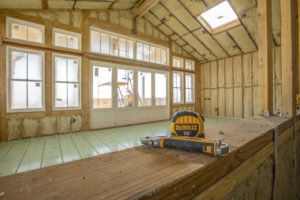The attributes that make wool insulation good for your van are the same ones that make it good for your home. Indeed, we began Havelock Wool with the residential market in mind but early on we discovered that this wildly dynamic fiber also made for great van insulation. It helps that we own a van insulated with Havelock!
Fast forward a few years and we are growing our market share nicely in both homes and vans. But we still do get the occasional question from vanlifers…. “Wait, this would work in a house too?” The answer is a resounding yes. Here’s a few reasons why.
Just like a van, homes accumulate moisture
According to ASHRAE, a family of 4 produces an average 2.5 gallons of water vapor every single day in their home– by breathing, cooking, taking showers, etc. This moisture creates real problems – poor air quality, mold, structural damage. The same things that can happen in a van. Wool in your home’s walls actively manages this moisture.
real problems – poor air quality, mold, structural damage. The same things that can happen in a van. Wool in your home’s walls actively manages this moisture.
Air quality matters
This is a big issue for vanlifers. A small space with toxic or even just less-than-ideal air quality is a deal breaker for many. The same applies to a home where indoor air is often 2-5 times more polluted than outside air. Considering that most Americans spend around 90% of their time indoors, this is something that we all need to take seriously. And just to state the obvious, poor indoor air quality causes a host of bad things from headaches to asthma to cancer. In comes Havelock Wool with it’s ability to passively absorb harmful chemicals in the air.
Borderline fun to install?
If you’ve put Havelock Wool in your van then you have a good understanding of what it’s like to work with a healthy, natural material that isn’t harmful to your health. Some folks even claim it is fun to install. The same applies to putting wool in your home. No PPE is required, you can literally get hands-on with your insulation.
But homes do require a different Havelock product
Compared to a van, a home has more uniform and thicker wall cavities and there is also a lot more area to insulate. So for homes we offer different products to meet these requirements:
Blown-in (loose fill) insulation : These knops (or balls) of wool are most commonly blown into a cavity with a machine, creating exceptional coverage and performance, i.e. R-value. The installation process can be more involved than that of batts.That said, for smaller projects hand stuffing of blown-in is quite popular… AND it ships immediately with a generally lower shipping cost than batts. You can pretty much use in any home application.
Batts : Our residential batts are very similar to the ones in your van, though we offer different sizing for different types of cavities. Our R13 batt is for 2×4 framing (3.5 inches) and we offer both 16in and 24in width. R20 batts are for 2×6 (5.5 inches) framing and again, we have 16in and 24in widths. These batts work across most home application and no machinery except for a stapler required.
In sum, we immensely appreciate the support we get in both vans and homes, but we did want to stop and make sure any doubt is removed from the equation. Wool is a great insulator wherever you put it – in your vans, in your homes or on your feet!

Is a moisture barrier required in vans with Havelock?
Nope! Wool manages moisture really well on its own!
Where is your company located
204 Edison Way, Reno Nevada!
Good idea
We are winterizing our cottage. Can I use foil-sided plastic sheeting as the vapour barrier in a vaulted ceiling for extra R value. It is an older cottage with a good aluminum roof. We are opening up the ceiling and building a loft on the other half over the 2 bedrooms & bathroom.
If you are converting from a traditional vented attic to a non-vented, in cold climates, spray foam is the only choice without taking the roof off. As for using plastic foil to get more R value, we suggest asking the manufacturer of that product. Thanks for reaching out.
I’m doing a skoolie build and using this product. I wanted to add a heat barrier, do I really need one with this product?
Our experience has shown that a heat barrier is not needed. Thanks!
Are there any plans to make a foil or paper backed version of the batts ? My thought is it might be easier to install, esp. in a van. Still like it tho.
No plans as of now! Thanks!
I used your wool for my van and it’s been fantastic! I also found that a electric kitchen knife cuts it like butter a little tip you could pass on to your customers.